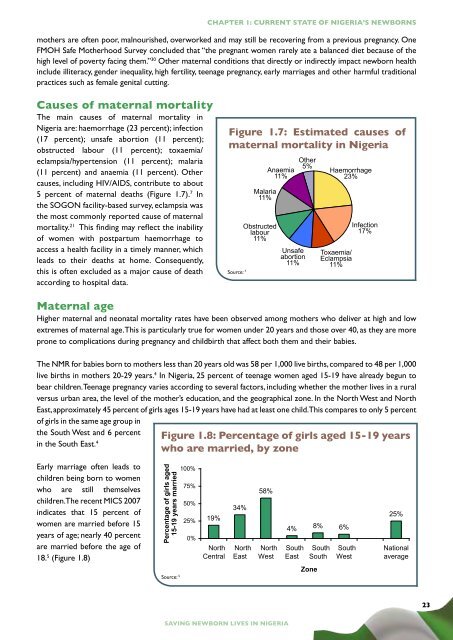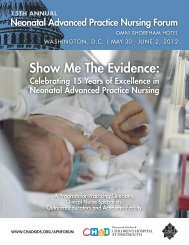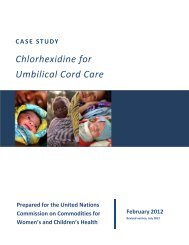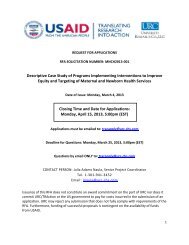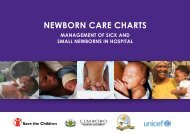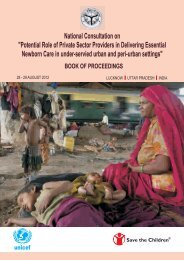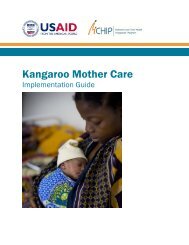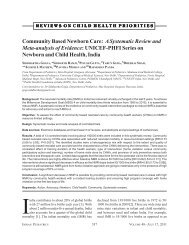CHAPTER 1: CURRENT STATE OF NIGERIA’S NEWBORNSWhere do newborns die?More than half of African babies who die do so athome. The place where mothers give birth, whichusually indicates whether the birth is attendedby skilled birth attendants, is strongly associatedwith the place of death and also with levels ofmaternal and neonatal mortality. According tothe 2003 NDHS, approximately 66 percent ofbirths occur at home, while only 34 percent takeplace in a health facility. 4 Of these health facilitydeliveries, approximately half take place in privatesector facilities, and the other half in public sectorfacilities (Figure 1.6). Rates of facility deliveries arehigher for women in urban centres (54 percent),mothers who have greater than a secondary leveleducation (88 percent) and those in the highestwealth quintile (80 percent). 4Figure 1.6: Distribution of birthsin Nigeria by place of birthSource: 4At home66%Other/missing1% Public facility18%Private facility14%<strong>Newborn</strong> Survival and Maternal HealthA mother’s health is inextricably linked to the health of her newborn. Maternal mortality is not just a healthproblem – it has far-reaching medical, social and economic implications for the newborn, family, communityand the world at large. When mothers are malnourished, or receive inadequate antenatal care and care duringchildbirth, they and their babies face a higher risk of disease and premature death.A staggering 47,000 Nigerian women die each year giving birth for every maternal death at least six newbornsdie and a further 4 babies are stillborn. 7 Nigeria’s maternal mortality ratio (MMR) is estimated to be 800 deathsper 100,000 live births. 25 As maternal deaths in Nigeria are not systematically registered there is a wide rangeof estimates of maternal mortality ratio. One modelled estimate for 2005 quotes a higher MMR of 1100 withuncertainty bounds of 440-2000. 26 While some uncertainty surrounds the exact estimate, these figures are muchtoo high compared to industrialised countries, where the average MMR is 8 deaths per 100,000 live births. 1There are a number of maternal health champions in Nigeria but a lack of reliable data disaggregated by statewhich has contributed to a <strong>situation</strong> in which most state governors and local government heads are unaware ofproblems in their own areas and avoid acting on maternal mortality. 27 One 2006 analysis of political priority formaternal health in Nigeria describes an open policy window for safe motherhood after decades of neglect. 28 Sincethe analysis, this policy window has broadened to include maternal, newborn and child health.Two-thirds of maternal deaths in Nigeria occur during childbirth, closely linked to an estimated 55,000 intrapartumstillbirths each year in Nigeria. For every woman that dies during pregnancy or childbirth, around thirty womenare estimated to suffer short and long-term disabilities, such as fistula, anaemia, pelvic infection, malnutrition anddepression, all of which can lead to reduced economic productivity. Nigeria accounts for 40 percent of the globalburden of obstetric fistula with an estimated 800,000 sufferers. 29In developing countries, a mother’s death in childbirth means almost certain death for her newborn. Those whosurvive infancy often face serious challenges to their growth, development and long-term survival. Studies haveshown that children who lose their mothers during childbirth have a 66 percent higher risk of death than thosewhose mothers survive. 20 <strong>Newborn</strong> death rates are highest in regions where maternal death rates are highest.Nigeria’s high neonatal mortality rate reflects a vicious cycle common in many low-resource settings. Pregnant22SAVING NEWBORN LIVES IN NIGERIA
CHAPTER 1: CURRENT STATE OF NIGERIA’S NEWBORNSmothers are often poor, malnourished, overworked and may still be recovering from a previous pregnancy. OneFMOH Safe Motherhood Survey concluded that “the pregnant women rarely ate a balanced diet because of thehigh level of poverty facing them.” 30 Other maternal conditions that directly or indirectly impact newborn healthinclude illiteracy, gender inequality, high fertility, teenage pregnancy, early marriages and other harmful traditionalpractices such as female genital cutting.Causes of maternal mortalityThe main causes of maternal mortality inNigeria are: haemorrhage (23 percent); infection(17 percent); unsafe abortion (11 percent);obstructed labour (11 percent); toxaemia/eclampsia/hypertension (11 percent); malaria(11 percent) and anaemia (11 percent). Othercauses, including HIV/AIDS, contribute to about5 percent of maternal deaths (Figure 1.7). 7 Inthe SOGON facility-based survey, eclampsia wasthe most commonly reported cause of maternalmortality. 21 This finding may reflect the inabilityof women with postpartum haemorrhage toaccess a health facility in a timely manner, whichleads to their deaths at home. Consequently,this is often excluded as a major cause of deathaccording to hospital data.Figure 1.7: Estimated causes ofmaternal mortality in NigeriaSource: 7Malaria11%Obstructedlabour11%Anaemia11%Unsafeabortion11%Other5%Haemorrhage23%Toxaemia/Eclampsia11%Infection17%Maternal ageHigher maternal and neonatal mortality rates have been observed among mothers who deliver at high and lowextremes of maternal age. This is particularly true for women under 20 years and those over 40, as they are moreprone to complications during pregnancy and childbirth that affect both them and their babies.The NMR for babies born to mothers less than 20 years old was 58 per 1,000 live births, compared to 48 per 1,000live births in mothers 20-29 years. 4 In Nigeria, 25 percent of teenage women aged 15-19 have already begun tobear children. Teenage pregnancy varies according to several factors, including whether the mother lives in a ruralversus urban area, the level of the mother’s education, and the geographical zone. In the North West and NorthEast, approximately 45 percent of girls ages 15-19 years have had at least one child. This compares to only 5 percentof girls in the same age group inthe South West and 6 percentin the South East. 4Figure 1.8: Percentage of girls aged 15-19 yearswho are married, by zoneEarly marriage often leads tochildren being born to womenwho are still themselveschildren. The recent MICS 2007indicates that 15 percent ofwomen are married before 15years of age; nearly 40 percentare married before the age of18. 5 (Figure 1.8)Percentage of girls aged15-19 years married100%75%50%34%25% 19%Percentage of girls0%aged 15-19 years marriedNorth NorthCentral East58%NorthWest4%SouthEast8% 6%SouthSouthSouthWest25%NationalaverageSource: 5Zone23SAVING NEWBORN LIVES IN NIGERIA


